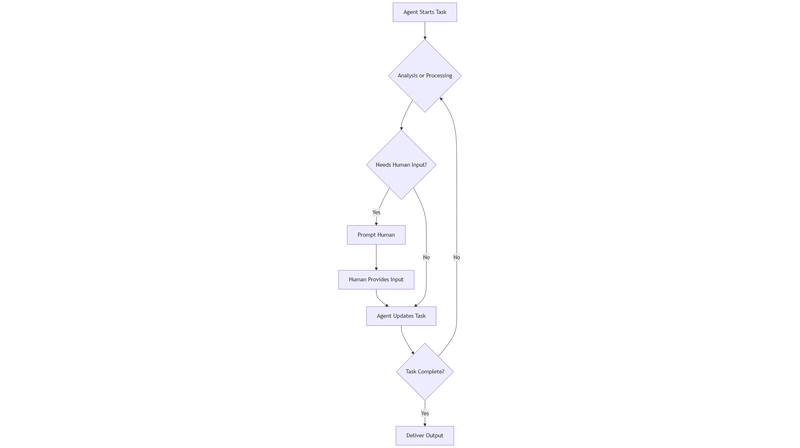Practical Human-in-the-Loop Agents: A Hands-On Guide
Human-in-the-Loop (HITL) agents are a powerful way to blend automation with human judgment. They’re perfect for tasks where you want speed and scale but can’t risk errors or need a human touch. This guide dives into what HITL agents are, how to build them, and walks you through practical examples using ag2. Let’s jump in and start coding. What Are Human-in-the-Loop Agents? HITL agents are systems that automate tasks but pause to get human input at critical moments. They’re not fully independent—they rely on you to approve, tweak, or reject their work when things get tricky or important. For developers, this means creating workflows where agents handle the grunt work (like crunching data or drafting plans) while humans make the big calls. It’s a teamwork vibe: the agent cranks through tasks, and you ensure the output is spot-on. Why bother with HITL? Catches errors in high-stakes tasks. Adapts to subjective needs like creative content. Keeps humans in control for trust and accountability. How HITL Workflows Flow An HITL system follows a simple loop: The agent kicks off a task (e.g., analyzing transactions, drafting a lesson). It checks if human input is needed (based on rules or uncertainty). If yes, it prompts the human for feedback or approval. The human responds, and the agent updates its work. Rinse and repeat until the task is done. Here’s a visual of the flow: For more on agent workflows, see ag2’s ConversableAgent docs. When to Use HITL Agents HITL shines when mistakes are costly or judgment is nuanced. Use it for: Critical domains: Think fraud detection, medical reviews, or legal checks. Creative work: Lesson planning or content creation where tone matters. Personalized outputs: Adapting results to specific user needs. For instance, an agent might auto-approve small payments but flag big ones for your review. It’s about balancing efficiency with caution. Setting Up Your HITL Environment Before you code, you’ll need: A language model (e.g., GPT-4o-mini or Gemini). The ag2 framework for agent communication. API keys (e.g., set OPENAI_API_KEY as an environment variable). Quick setup: Install ag2: pip install ag2[openai]. Create a config file (OAI_CONFIG_LIST) with your API key and model. Ensure human_input_mode is settable in your agent. Tip: Start with a lightweight model like gpt-4o-mini to keep costs low while testing. Example 1: Crafting a Lesson Planning Agent Let’s build an HITL agent that drafts lesson plans for fourth graders. The agent creates the plan, but you (the teacher) review and adjust it before it’s finalized. Code Walkthrough from ag2 import ConversableAgent, LLMConfig # Set up the LLM llm_config = LLMConfig(api_type="openai", model="gpt-4o-mini") # Define agent instructions planner_system_message = """ You are a classroom lesson agent. Given a topic, write a lesson plan for a fourth-grade class. Use this format: Lesson Plan Title Key objectives How to introduce the topic """ # Create the lesson agent with llm_config: lesson_agent = ConversableAgent( name="lesson_agent", system_message=planner_system_message, human_input_mode="ALWAYS" # Always ask for human input ) # Create the human agent (you) human = ConversableAgent( name="human", human_input_mode="ALWAYS" ) # Start the chat human.initiate_chat( recipient=lesson_agent, message="Create a lesson plan about the water cycle." ) What’s Going On? The agent drafts a lesson plan with a title, objectives, and intro. It pauses to ask you (via terminal) to approve or suggest changes. You might say, “Add a group activity,” and the agent updates the plan. Once you’re happy, it locks in the final version. Sample Output The Water Cycle Journey - Learn evaporation, condensation, and precipitation. - Spot the water cycle in everyday life. Show a diagram of the water cycle. Ask kids: "What happens to water in a puddle?" Why it rocks: The agent sets up the framework, but you make it engaging for students. Example 2: Financial Fraud Detection Agent Now let’s create an agent that scans transactions and flags suspicious ones for your approval. It’s great for catching fraud while keeping legit payments moving. Code Walkthrough from ag2 import ConversableAgent, LLMConfig import random # LLM setup llm_config = LLMConfig(api_type="openai", model="gpt-4o-mini") # Agent instructions finance_system_message = """ You are a financial compliance assistant. Process transactions one by one: - If suspicious (amount > $10,000, vague memo, or odd vendor), ask human for approval. - Otherwise, auto-approve. After processing, provide a report: - Approved: ... - Denied: ... - Awaiting Human Decision: ... """ # Create the finance agent with llm_config: finance_bot = ConversableAgent( name="finance_bot", system_message

Human-in-the-Loop (HITL) agents are a powerful way to blend automation with human judgment.
They’re perfect for tasks where you want speed and scale but can’t risk errors or need a human touch.
This guide dives into what HITL agents are, how to build them, and walks you through practical examples using ag2. Let’s jump in and start coding.
What Are Human-in-the-Loop Agents?
HITL agents are systems that automate tasks but pause to get human input at critical moments.
They’re not fully independent—they rely on you to approve, tweak, or reject their work when things get tricky or important.
For developers, this means creating workflows where agents handle the grunt work (like crunching data or drafting plans) while humans make the big calls.
It’s a teamwork vibe: the agent cranks through tasks, and you ensure the output is spot-on.
Why bother with HITL?
- Catches errors in high-stakes tasks.
- Adapts to subjective needs like creative content.
- Keeps humans in control for trust and accountability.
How HITL Workflows Flow
An HITL system follows a simple loop:
- The agent kicks off a task (e.g., analyzing transactions, drafting a lesson).
- It checks if human input is needed (based on rules or uncertainty).
- If yes, it prompts the human for feedback or approval.
- The human responds, and the agent updates its work.
- Rinse and repeat until the task is done.
Here’s a visual of the flow:
For more on agent workflows, see ag2’s ConversableAgent docs.
When to Use HITL Agents
HITL shines when mistakes are costly or judgment is nuanced. Use it for:
- Critical domains: Think fraud detection, medical reviews, or legal checks.
- Creative work: Lesson planning or content creation where tone matters.
- Personalized outputs: Adapting results to specific user needs.
For instance, an agent might auto-approve small payments but flag big ones for your review. It’s about balancing efficiency with caution.
Setting Up Your HITL Environment
Before you code, you’ll need:
- A language model (e.g., GPT-4o-mini or Gemini).
- The ag2 framework for agent communication.
- API keys (e.g., set
OPENAI_API_KEYas an environment variable).
Quick setup:
- Install ag2:
pip install ag2[openai]. - Create a config file (
OAI_CONFIG_LIST) with your API key and model. - Ensure
human_input_modeis settable in your agent.
Tip: Start with a lightweight model like gpt-4o-mini to keep costs low while testing.
Example 1: Crafting a Lesson Planning Agent
Let’s build an HITL agent that drafts lesson plans for fourth graders. The agent creates the plan, but you (the teacher) review and adjust it before it’s finalized.
Code Walkthrough
from ag2 import ConversableAgent, LLMConfig
# Set up the LLM
llm_config = LLMConfig(api_type="openai", model="gpt-4o-mini")
# Define agent instructions
planner_system_message = """
You are a classroom lesson agent.
Given a topic, write a lesson plan for a fourth-grade class.
Use this format:
Lesson Plan Title
Key objectives
"""
# Create the lesson agent
with llm_config:
lesson_agent = ConversableAgent(
name="lesson_agent",
system_message=planner_system_message,
human_input_mode="ALWAYS" # Always ask for human input
)
# Create the human agent (you)
human = ConversableAgent(
name="human",
human_input_mode="ALWAYS"
)
# Start the chat
human.initiate_chat(
recipient=lesson_agent,
message="Create a lesson plan about the water cycle."
)
What’s Going On?
- The agent drafts a lesson plan with a title, objectives, and intro.
- It pauses to ask you (via terminal) to approve or suggest changes.
- You might say, “Add a group activity,” and the agent updates the plan.
- Once you’re happy, it locks in the final version.
Sample Output
The Water Cycle Journey
- Learn evaporation, condensation, and precipitation.
- Spot the water cycle in everyday life.
Why it rocks: The agent sets up the framework, but you make it engaging for students.
Example 2: Financial Fraud Detection Agent
Now let’s create an agent that scans transactions and flags suspicious ones for your approval. It’s great for catching fraud while keeping legit payments moving.
Code Walkthrough
from ag2 import ConversableAgent, LLMConfig
import random
# LLM setup
llm_config = LLMConfig(api_type="openai", model="gpt-4o-mini")
# Agent instructions
finance_system_message = """
You are a financial compliance assistant. Process transactions one by one:
- If suspicious (amount > $10,000, vague memo, or odd vendor), ask human for approval.
- Otherwise, auto-approve.
After processing, provide a report:
- Approved: ...
- Denied: ...
- Awaiting Human Decision: ...
"""
# Create the finance agent
with llm_config:
finance_bot = ConversableAgent(
name="finance_bot",
system_message=finance_system_message
)
# Human agent
human = ConversableAgent(
name="human",
human_input_mode="ALWAYS"
)
# Generate random transactions
VENDORS = ["OfficeMax", "TechBit", "RiskyCo", "ShopEasy"]
MEMOS = ["Supplies", "Consulting", "Urgent", "Misc"]
def generate_transaction():
amount = random.choice([500, 2000, 12000, 15000])
vendor = random.choice(VENDORS)
memo = random.choice(MEMOS)
return f"Transaction: ${amount} to {vendor}. Memo: {memo}."
transactions = [generate_transaction() for _ in range(3)]
# Kick off processing
initial_prompt = "Process these transactions:\n" + "\n".join([f"{i+1}. {tx}" for i, tx in enumerate(transactions)])
human.initiate_chat(
recipient=finance_bot,
message=initial_prompt
)
What’s Happening?
- The agent reviews each transaction against rules (e.g., amount > $10,000).
- For sketchy ones, it asks you to approve or deny.
- You might respond, “Deny $12,000 to RiskyCo,” and it records that.
- It wraps up with a report of all decisions.
Sample Report
- Approved: $500 to ShopEasy, $2000 to OfficeMax
- Denied: $12000 to RiskyCo
- Awaiting Human Decision: None
Why it works: The agent spots red flags, but you have the final say to avoid mistakes.
Avoiding Common HITL Hiccups
HITL agents aren’t foolproof. Here’s what can go wrong and how to fix it:
| Issue | Fix |
|---|---|
| Too many human prompts | Define strict rules for when to ask (e.g., only flag > $10,000). |
| Unclear agent behavior | Write detailed system_message for tasks and outputs. |
| API key issues | Verify environment variables and config before running. |
| Slow testing | Use small datasets to iterate fast during development. |
Tip: Save human inputs to a log to refine your agent’s logic over time.
Leveling Up Your HITL Agents
Ready to go further? Try these:
- Add memory: Store human decisions in a database to improve the agent.
- Build a UI: Swap terminal prompts for a web app to streamline input.
- Use multiple agents: Have one generate outputs and another check them before you review.
This guide gives you the tools to start building HITL agents with ag2. From lesson plans to fraud detection, it’s all about mixing automation with human smarts. Play with the code above, tweak it, and share your thoughts in the comments!









































































































































































![[The AI Show Episode 144]: ChatGPT’s New Memory, Shopify CEO’s Leaked “AI First” Memo, Google Cloud Next Releases, o3 and o4-mini Coming Soon & Llama 4’s Rocky Launch](https://www.marketingaiinstitute.com/hubfs/ep%20144%20cover.png)




























































































































![[DEALS] The All-in-One Microsoft Office Pro 2019 for Windows: Lifetime License + Windows 11 Pro Bundle (89% off) & Other Deals Up To 98% Off](https://www.javacodegeeks.com/wp-content/uploads/2012/12/jcg-logo.jpg)



























![Is this too much for a modular monolith system? [closed]](https://i.sstatic.net/pYL1nsfg.png)






















































































































_Andreas_Prott_Alamy.jpg?width=1280&auto=webp&quality=80&disable=upscale#)
































































































![What features do you get with Gemini Advanced? [April 2025]](https://i0.wp.com/9to5google.com/wp-content/uploads/sites/4/2024/02/gemini-advanced-cover.jpg?resize=1200%2C628&quality=82&strip=all&ssl=1)













![Apple Shares Official Trailer for 'Long Way Home' Starring Ewan McGregor and Charley Boorman [Video]](https://www.iclarified.com/images/news/97069/97069/97069-640.jpg)
![Apple Watch Series 10 Back On Sale for $299! [Lowest Price Ever]](https://www.iclarified.com/images/news/96657/96657/96657-640.jpg)
![EU Postpones Apple App Store Fines Amid Tariff Negotiations [Report]](https://www.iclarified.com/images/news/97068/97068/97068-640.jpg)
![Apple Slips to Fifth in China's Smartphone Market with 9% Decline [Report]](https://www.iclarified.com/images/news/97065/97065/97065-640.jpg)




































































































































